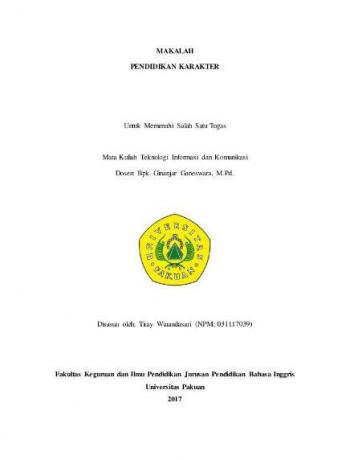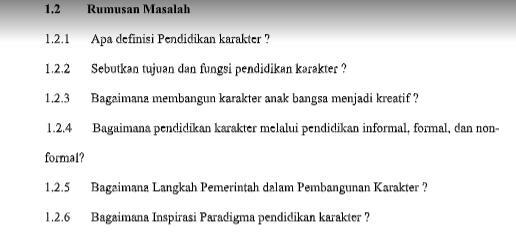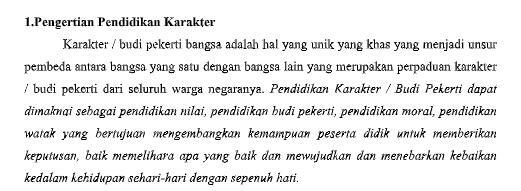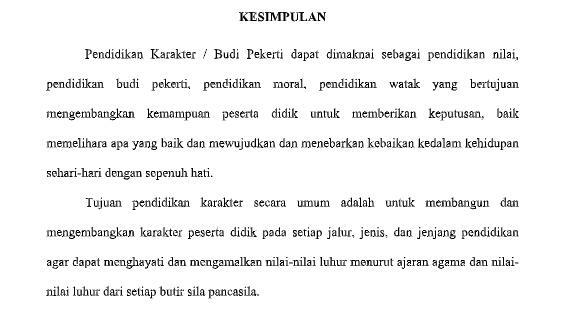How to Make a Paper with a Good and Correct Structure
X
Advertisements
Loading...
In compiling a paper, winning is easy - easy, difficult, because you have to pay attention to the rules of how to make the right paper.
For those of you who are still confused in making the paper, here we will provide some information related to the paper that you can study. Listen well yes.
list of contents
Understanding Papers

Advertisement
In general, a paper is usually referred to as a written work in which the thoughts of an author have never been published which are scientific in nature.
In addition, several experts also convey the meaning of the paper as:
A written description put forward to obtain further discussion according to W.J.S Poerwadarminta (1994).
And in the Big Indonesian Dictionary (KBBI) it is also interpreted in two senses, namely official writing related to a letter subject that is intended to be read publicly at a trial and which is often drawn up to published; student or student writing as a report on the results of the implementation of school or college assignments.
Characteristics of a Good Paper

Determination or selection of a paper can be said to be good if it has the following characteristics:
1. Contribution
One of the characteristics of a good paper is that it is able to contribute to several aspects, including:
- New theory development or innovation.
- Improved use of the method.
- Benefits and applicable implications.
2. Originality
Does not contain repetition of other studies, such as:
- Researched problem.
- Approach.
- Conceptual framework.
3. Problem Statement
Existence:
- Research statement
- A description of the association of two or more measurable phenomena.
4. Feasibility Aspect
Namely:
- Can be answered.
- The level of knowledge and skills possessed.
- There are time and cost considerations.
- The carrying capacity of facilities and other resources.
5. Paper Content Terms
The following are some of the criteria that must be met in a paper, namely:
- Be careful.
- On time.
- Adequate.
- Simple.
- Clear.
Types of Papers

Before knowing several types of papers, you must first know the following 3 categories of papers:
a. Deductive Papers
Is a paper based on relevant theoretical studies with the problems discussed in it.
b. Inductive Paper
Is a paper that is written seen from empirical data that is objective in nature based on what is obtained from the field but remains relevant to the discussion.
c. Mixed Papers
Is a paper that is compiled or written based on theoretical studies and empirical data.
Which means, this one mixed paper is a combination or a combination of a deductive paper with an inductive paper.
nowAfter knowing the three categories, here are the types of papers that you need to know, including:
1. Working Paper
This type of paper is obtained from the results of a study.
The difference with a scientific paper, this working paper allows the authors to provide a subjective opinion of the problem being discussed.
2. Scientific Papers
Scientific paper is a paper in which it discusses problems related to the results of scientific studies.
The content in this type of paper may not be based solely on opinions or opinions that are subjective.
3. Study Paper
A study paper is a paper that contains various ways of solving a controversial problem.
4. Position Paper
Position paper is a paper whose preparation is done at the request of a party.
Advertisement
The function of this type of paper is to be an alternative solution to an existing problem.
5. Response Paper
This type of paper is the one most often obtained by a student or student as an assignment given by the teacher or lecturer.
The content in this paper is the author's response or reaction to an ongoing problem.
6. Analysis Paper
As the name implies, this type of paper contains a variety of analysis of a problem that is objective and empirical.
Paper Structure
Before you go to the process of how to make a paper, then you should know in advance what the structure of the paper is to make it easier for you to compile it later.
The following is the structure of the paper that you need to know, including:
1. Cover
Cover is a cover of a paper in which there is a logo, title, author's identity, and place and year of publication.
In this part of the cover, it is better if the writing uses the center rule so that the cover will look neater.
An example of a cover from a paper that you can use as a reference:

2. Foreword
The introduction is also one of the mandatory parts in a paper.
As the name suggests, the function in the preface is to serve as an introduction so that readers will have an overview or general view of the contents of the paper.
There are many different ways to write a preface.
More, you can see some example of introduction which you can use in your later paper.
3. List of contents
Table of contents is a page whose contents are page information of a paper content.
In order to make it easier for readers to find certain information, then you must provide page descriptions in each chapter or sub-chapter in your paper.
Example table of contents:

4. introduction
In the introduction, it generally consists of 3 sub-chapters, namely background, problem formulation, and objectives.
Here's the explanation:
a. Background
The essence of a background is an answer to the various questions that led to the making of the paper, such as:
- Why are you guys discussing that topic?
- What made you want to solve the problem?
- What are you doing the research for?
In writing the background must also be written clearly and easy to understand.
Not only should it contain answers to various questions, this background must also contain various supporting data and facts.
Example:

b. Formulation of the problem
On the side of the problem formulation section, you can also fill in some questions which you will explain later in the discussion section.
The questions don't need to be too many, you only need 2 to 3 clear questions and are the result of "shrinking" from the background that you wrote earlier.
Example:

c. Purpose
As the name implies, the purpose is a section whose contents are related to the purpose of the paper.
In this section, you can write briefly and clearly describe the benefits of making the paper.
Example goals:
Advertisement

5. Discussion/ Content
Discussion or content is the most important part of a paper.
In part one, it contains a description of the main problems that you will discuss.
Of course, the discussion in this content section must match the background, problem formulation, and goals that you wrote earlier.
The content generally includes the theoretical basis, description of the material, and also the completion or solution of a problem.
Example of discussion/content:

6. Closing
The closing section generally consists of various sub-chapters, conclusions and suggestions, along with explanations:
a. Conclusion
The conclusion is related to a summary or summary related to the results of the discussion of the paper that you made.
To write in this section, you can analyze the important points in the previous sections in order to come up with a conclusion from the problems that you have discussed.
Example conclusion:

b. Suggestion
Suggestion is one section that is intended for readers.
In this suggestion section, the writer hopes that the paper made can be useful and applied by the reader.
Example suggestions:

7. Bibliography
This section contains a list of references used by the author when writing a paper.
The list of references used can be in the form of books, journals, or various valid information from the internet.
How to Make Papers

The following are tips on how to make a good and correct paper, of course, it is easy for you to follow, read carefully.
1. Determining the Theme or Topic of Discussion
In making a paper, the first thing you have to do is determine the theme or topic you want to discuss.
Advertisement
If you get assignments from teachers or lecturers and the theme has been determined, then you can go directly to the next stage.
However, if you haven't, you have to think about the theme or topic first.
This is because, in choosing a theme, it can affect the level of difficulty and also the estimated time to work on the paper itself.
As much as possible, you choose a theme that if you have mastered and have more insight into that topic.
2. Determining the Title of the Paper
After you have found the theme or topic that you want to discuss, then the next step is to determine the title of the paper that you will make.
Make the title as catchy as possible.
Not only interesting, the title you make must also be clear and related to the theme you have chosen.
3. Collecting Reference Materials
After you have a theme and title, now is the time for you to collect reference materials that can support the process of preparing your paper.
You can get this reference from various books, journals, and articles on the internet.
Especially for articles that you find on the internet, choose one whose source is clear and can be accounted for.
4. Writing Papers Systematically
After obtaining the reference material, now is the time for you to start writing your paper.
In writing a paper, it is better if you do it systematically according to the structure of the paper that has been described previously.
You can start from the introduction, focus on the content of the paper, then close with a clear conclusion.
Don't forget that in writing a paper, you also have to deal with existing data or facts.
In essence, you must always be objective when discussing existing problems and followed by solutions.
5. Edit Papers
After the paper you have made has been finished, don't be in a hurry for you to publish. Research and correct if there are errors in the paper that you have made.
Also check first whether the paper that you have made is in accordance with the structure of the existing paper.
And don't forget to check the spelling, writing, language, and paper margins that you apply.
After you are sure that everything is in order, then you can publish the paper you have written earlier.
Conclusion
In making a paper, an author must be able to pay attention to several important points to facilitate the preparation and clarify the contents of the paper.
Not only the structure of the paper, the author must also be able to pay attention to grammar and also the reference sources used.
Simply put, the paper is a scientific paper in which the discussion is focused to a particular problem and has gone through the process of research, observation and field research correctly and actual.
The discussion of the content of the problems in the paper is related to a subject or in a particular field of specialization.
